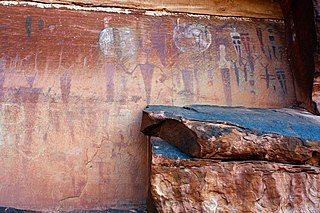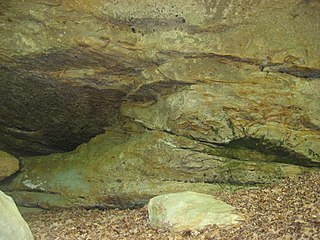Related Research Articles

Hueco Tanks is an area of low mountains and historic site in El Paso County, Texas, in the United States. It is located in a high-altitude desert basin between the Franklin Mountains to the west and the Hueco Mountains to the east. Hueco is a Spanish word meaning hollows and refers to the many water-holding depressions in the boulders and rock faces throughout the region. Due to the unique concentration of historic artifacts, plants and wildlife, the site is under protection of Texas law; it is a crime to remove, alter, or destroy them.

Pictograph Cave is an area of three caves located 5 miles (8.0 km) south of Billings, Montana, United States, preserved and protected in the 23-acre (9.3 ha) Pictograph Cave State Park.

This is a list of the National Register of Historic Places listings in Pueblo County, Colorado, USA.

The Courthouse Wash Pictographs are a series of large pictographs created over a long period of time, located on a sheltered sandstone wall at the mouth of Courthouse Wash, Arches National Park in Grand County, Utah, United States, just north of Moab, that is listed on the National Register of Historic Places (NRHP).

Seminole Canyon State Park and Historic Site is a state park in the U.S. state of Texas. It is located off U.S. Route 90, east of the Pecos River High Bridge, 9 miles (14 km) west of Comstock in Val Verde County. The park is conducive to camping, biking, bird watching, back packing and archeological study. Cave art and archeological artifacts date back to the earliest human habitation in the area. The park is part of the larger Seminole Canyon Archeological District on the National Register of Historic Places.
Archeological Site CA-INY-134, in Inyo County, California near Olancha, California, is an archeological site that is listed on the National Register of Historic Places (NRHP). The site is located in the Coso Range 6 miles (9.7 km) northwest of Coso Hot Springs. It has also been known as Ayer's Rock Pictograph Site, as Bob Rabbit's Pictographs, as INY-134 and as INY-105. Prehistorically, it served as a camp and as a ceremonial site. The site includes three pictograph panels carved into a monolith. The pictographs are painted in a variety of colors and depict animal and human figures.

The Piney Creek West Site is a prehistoric rock art site located north of Piney Creek in Piney Creek Ravine State Natural Area in Randolph County, Illinois. The site consists of four petroglyphs painted on the inside of a rock shelter and a pictograph painted on the outside. The interior petroglyphs include an abstract shape, two curved lines, and a serpentine line with a pit at one end; two of the petroglyphs are filled in with ochre pigment, representing the only intact example of this painting technique in Illinois. The pictograph, which has deteriorated badly, depicts a human left hand; nearby flecks of paint from an unrecognizably faded figure likely indicate the site of the right hand. The paintings were likely added during the Late Woodland period, which lasted from 450 to 900 A.D. The serpentine figure inside the shelter suggests that the site had spiritual significance, as it resembles other prehistoric rock art depicting shamanic trance states.
Aiken's Wash is an archaeologically and geologically significant wash located in the Mojave National Preserve in San Bernardino County, California. The wash includes several pictograph and petroglyph sites dating from the late pre-Columbian period. The proximity of pictographs and petroglyphs is unusual in the Mojave Desert region. The area was added to the National Register of Historic Places as the Aiken's Wash National Register District. The district comprises 1,450 acres (590 ha), including all major archaeological sites in the wash.
Maine Archaeological Survey site 21.26 is a Native American rock art site in Lovell, Maine. The site is on a rock formation that overlooks a lake in an area known to be frequented in historical times by bands of Abenaki. It has depictions of human figures, including two stick-like figures with raised arms, as well as a third image that has apparently been partially destroyed. These images were creating by pecking or dinting, probably with a stone tool. The artwork also included the use red ochre, and was generally overlaid by carbonaceous material dated by radiocarbon dating methods to about 1,000 BCE. The site was visited by state archaeologists in 1991, who mapped, photographed, and took surface plaster prints of the images.
The Sunburst Shelter, designated by the survey number 3MR94, is an archaeological site in Marion County, Arkansas. A notable feature of the site is a pictograph depicting a sunburst. Painted in red pigment onto a limestone surface with fingers, the pictograph was described as being in fair condition in 2003, with flaking paint and water staining, and some vandalism to the area.
Brown Bluff is a rock art site in Washington County, Arkansas. The site consists of a prepared panel of sandstone extending some 80 metres (87 yd), on which have been painted pictographs in red. The site has been estimated to date to the Mississippian period, c. AD 1100–1600. The artwork is reminiscent of artwork found in the Arkansas River valley, and is one of the few places such artwork has been found in the western Ozark Mountains.

The Chugai' Pictograph Site is a prehistoric rock art site on the island of Rota in the Northern Mariana Islands. The rock art is located in a limestone cave on the southeastern side of the island, in the I'Chenchon Bird Sanctuary. It consists of a large panel, 185 feet (56 m) in length, of about 90 painted drawings, believed to be of late pre-contact origin. The site is accessed via a trail cut by the Japanese during the South Seas Mandate period.
The Talagi Pictograph Cave is a rock art site on the island of Guam. It is located on property owned by the government of Guam within the bounds of Andersen Air Force Base on the northern part of the island near Tarague Beach. The cave contains thirteen pictographs representing human figures, and a places where limestone mortar was used that is of prehistoric origin. Based on the characteristics of the figures, it is believed that they were probably the work of a single individual. It is one of a small number known rock art sites on the island.
The Cooper's Bluff Site is a prehistoric panel of pictographs in Searcy County, Arkansas. Located under a sheltering overhang, it measures about 4.5 by 1.8 metres, and is accompanied by a scatter of prehistoric Native American artifacts. It is estimated to have been painted about 1500 CE.
The Pictograph Cave is a prehistoric rock art site near Mountain View, Arkansas. It consists of a panel of painted art, most of which is abstract wavy lines similar to art found at Petit Jean State Park. It is one of the furthest-removed expressions of this category of artwork from the Petit Jean area, and was listed on the National Register of Historic Places in 1982 for its information and research potential.

Petit Jean State Park is the oldest state park in Arkansas. It is located in the central northern part of the state, in western Conway County, atop Petit Jean Mountain, a ridge between the Ozark and Ouachita Mountains. One of the features the park is noted for is prehistoric rock art, some of which is accessible to park visitors via its hiking trails. A total of twelve such sites have been listed on the National Register of Historic Places for their importance. Most of the rock art has been dated to about 1500 CE, and is not obviously associated with habitation sites or other sites bearing evidence of other Native American activities.
The Serpent Cave is a prehistoric rock art site near Clarksville, Arkansas. It consists of a panel depicting a serpentine figure, a common motif in rock art of the Mississippian culture. Why a motif of that culture is found as far west as it is is unknown.
The White Rock Bluffs Archeological Pictograph Site in Texas County, Missouri is an archeological site with pictographs which is listed on the National Register of Historic Places. Its exact location has not been disclosed, though it is around 2 miles south of Bucyrus.
Big Gyp Cave Pictograph site (14CM305) in Comanche County, Kansas, is an archeological site with pictographs in a cave. It was listed on the National Register of Historic Places in 1978.

The Clam Cove Pictograph Site is a series of prehistoric rock art on the Gulf of Alaska coast of Lake Clark National Park and Preserve in southern Alaska. The site consists of a pair of pictograph panels, oriented facing south and west. Figures include numerous depictions of humans, and what appear to be killer whales. The site has long known to the local Alutiiq people, whose native corporation has identified it as a particular site of historic interest. It was first visited by an archaeologist in 1968, and its deteriorating figures have been recorded on a number of occasions since.
References
- 1 2 "National Register Information System". National Register of Historic Places . National Park Service. July 9, 2010.
- ↑ "Summary description of Fox pictograph". Arkansas Preservation. Retrieved July 26, 2015.